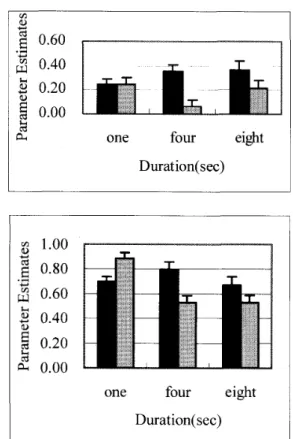The Japanese Psychonomic Society
NII-Electronic Library Service
The JapanesePsychonomic Society
The
foPanese
fournat
of
Ps.vchonotnicScience
20e5,
VoL
24,
No,
1,109-1IOSummary
ofAwarded
PresentationIP03
Effects
of
object
occlusion
on
brain
activity
for
representation
of
a
dynamic
scene
Toshihide
IMARuoKA*,
Jun
SAIKI**,
and
Satoru
MIyAucHI***
Kdnaaawa
institute
ofTechnotagy*,
JST
RI?ESTO;
K.voto
Ubeiversdy**,
AJdetional
inslilute
of
Communications
and
Technologyr***
In
aprevious
study wehave
shown,
by
using
functional
MRI
during
a
multiple
objectpermanence
tracking
(MOPT)
task,
that
the
representation ofdynamic
objects
needs
the
coopera-tion
of widespread neural systems(Imaruoka,
Saiki,
Miyauchi;
2005).
In
the
present
study we modifiedthe
MOPT
ta$k,
and
measured
the
brain
activityduring
the
task
withfMRI,
so
that
we
could explorethc
precise
correspondencc
of
a number of cognitiveprocesses
andneural
systemsrelated
to
the
representation
of
dynamic
objects,The
cognitiveprocesses
included
ebjecttracking,
the
maintenance
of visualinformation,
the
integration
of
visual spatialinforrnation,
and otherinformation
about an object.The
neuralsystems
included
the
anterior, superior,and
inferior
frontal
areas,and
the
parietal
area,
The
resuits suggested a close re}ationshipbctween:
(a>
the
rightsuperior
frontal
gyrus
and
the
maintenance oi acoherency
ofthe
dynamic
objects; and(b)
the
parietal
regions andthe
tracking
ofthe
visualobjects.
Key
words:object
representatien,
coherency,functiona]
MRI
We
have
previously
shownthat
the
representationof
visual
objectsin
adynamic
scene requiresa
morc widespread neural systemthan
that
for
a static scene.This
neural systemextended
from
the
anteriorfrontal
to
the
posterior
parietaL
brain
corticcs (Ima-ruoka,Saiki,
Miyauchi;
2005).
However,
the
precise
correspondencebetween
the
brain
regions andthc
various
cognitive
components, such asthe
tracking
ef
visual
ebjects,the
maintenance of visualinforma-tion,
andthe
integration
of spatialand
visual
infor-mation,
is
notwell
known,
The
aim
ofthe
present
study
was
to
clarify
the
correspondencebetween
a cognitiveprocess
andthe
neura] responscsby
vary-ing
both
the
length
efthc
occludcdperiod
of
the
dynamic
visual
objects
and
the
task
requirements.
Our
hypothesis
was
that
rnanipulation ofthe
oc-cludedduration
woulddifferentially
affect
the
*
College
ofInformatics
andHuman
tion,
Kanazawa
Institute
ofTechnology,
gaoka
7-1,
Nonoichi-machi,
Ishikawa
921-8501,
Japan
**
PRESTO,
Japan
Science
and
Technology
cy,
Kawaguchi,
Japan.
Graduate
School
ofmatics,
Kyoto
University,
Kyoto,
Japan
***
Brain
Information
Group,
Kansai
Advanced
search
Centcr,
National
Institute
ef
tions
andTechnology,
Kobe,
Japan
Cupyright
2005
ral
system
related
to
the
tracking
ofthc
object andthe
maintenance
ofvisual
information.
That
is,
pro-longation
ofthe
occludedperiod
would
produce
an additional cost onlyfor
the
maintenance
system andshortening
the
occludedperjod
wouldproduce
an
additional cost onlyfor
the
tracking
system. Further-inorc we variedthe
task
requirements asfollows.
The
subjects were rcquiredto
maintain only colorinformation
in
one ofthe
condjtions(intrusjon
condi-tion)
andte
maintain coherenceof
color
and spatialinformation
in
the
other
condition
(switch
condition}.The
two
experimental
factors
would enablcus
to
classify a number of
brain
regionsrelated
to
thc
representation of
the
dynamic
visual
objects.
Methods
The
participants
were6
paid
subjects whogave
their
informed
consenL
We
used
a
rnodified
versionof
the
MOPT
task
(SaikL
2003)
in
whichthe
subjects were requiredto
detect
a color change ofthe
disks
while viewing4
movingdisks
behind
4
stationary
gray
occluders,The
stirr]ulidiffered
trom
those
used
in
the
previous
study
in
the
following
two
experi-mental
factors.
Thc
first
difference
wasthe
manncrin
which
the
color changed,In
the
switch
cendition
the
colors of2
ofthc
4
disks
wcre
switched,
andthen
The Japanese Psychonomic Society
NII-Electronic Library Service
The JapanesePsychonomic Society
110
The
Japanese
Journal
ofPsychonomic
Science
Vol.
24,
No,
l
Table
1
Brain
regions showing a significant color change effect orinteraction.
Main
gffect
Color
changeL/R
SFG,
SMA,
LIFG
Switch/Duration'
Intrusion/Duration*
IntrusionfDuration**
InteracEl'on
..
R
SFG
L
plP
RfL
alP,R
plP
meeeo.6o'g
O.40pg
o.2og
o.oos
one
four
eightDuration(sec)
Abbreviations.
L,
left;
R,
right;SFG
superiorfronta]
gyrus;
SMA,
supplementary motor area:IFG,
infcrior
frontal
gyrus;
IP,
intraparietal
area;
*
Longer
duration
induced
highcr
activity. **Shorter
duratLon
induced
higher
activity.switched
back,
withinthe
stimu]usdisplay.
In
thc
intrusien
conditionhowever,
the
color
of
1
ofthe
4
disks
was
changed
to
a
color
that
was selectedfrom
a
pool
of colorsother
than
the
4
original colors.The
subjects were requiredto
maintaincoherence
ofthc
colorand
spatial
information
of
the
disks
in
the
switch
condition,
but
to
rnaintain
onLy
color
informa-tion
in
the
intrusion
condition.The
secondexperi-rnental
difference
wasthe
duration
of
the
occludedperiod
(1
second,4
seconds, or8
seconds>in
the
MOPT
time
series.We
measuredthe
brain
activitvduring
the
task
usrng a1.5T
functional
MRI
scanner.We
onlyassessed
the
effect
of
2
factors
on
the
brain
regions
that
wereactivated
by
the
MOPT
task
in
ourprevious
study(Imaruoka,
Saiki,
&
Miyauchi,
2005),
The
effects were measured withan
estimate
ofthe
parameter
values
obtained
in
the
individual
analysis
of
the
functional
imaging
data.
Results
and
Discussion
Of
the
10
interesting
regions8
regionshad
asig-nificant
main effectof
Coler
Change
or a significantinteraction
oftwo
factors
(Table
1;
Figure
1).
As
shown
in
Table
1
and
Figure
1,
the
effect
of
duration
length
was
not
identical
across
the
intcresting
re-gions,
The
maintenance costin
the
switch condition,OO,80.60.40.20,ooone
Du
Figure
1.
Parameter
estimate
valueobtained
from
interested
regions.
Upper
fig.,
right superiorfrontal
gyrus;
Lower
fig.,
rightpesterior
parietal
sulcus.
was
found
onlyin
the
right superiorfrontal
gyrus
(Figure
1)
suggesting a close relationshipbetween
that
region and maintenanceof
bound
representa-tion
of
color
and
spatial
information,
In
contrast,the
tracking
cost wasfound
in
mostparietal
regions(Table
1;
Figure
1)
suggesting
a eloserelationship
bctween
spatial
processing
and
the
parietal
regions,
